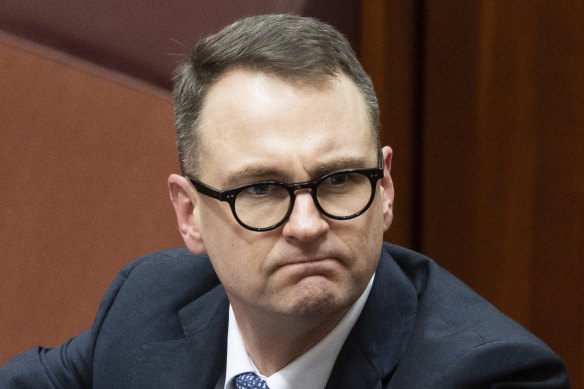This was published 3 months ago
Opinion
The harshest truth about our housing crisis? There’s no silver bullet
Shane Wright
Senior economics correspondentEvery time someone says they’ve got a new easy answer to Australia’s disastrous housing situation, a little bit of me dies.
Whether it’s the new YIMBYs, $10 billion housing funds, ending capital gains tax concessions or letting people access their superannuation early, all sides of politics reckon they have a silver bullet.

Liberal senator Andrew Bragg wants banks to look at how they assess HECS/HELP debt.Credit: Alex Ellinghausen
But none will hit their intended target. And in many cases, there will be even more collateral damage that the generations of young Australians who are being priced out of the property market will be forced to carry.
The most recent idea to be floated comes from Liberal senator Andrew Bragg, who has an inquiry to look at the issue of “financing for first home buyers”.
While Bragg previously supported the idea of young Australians accessing and using their superannuation for a deposit, he now wants to examine ways to reduce lending costs for first-time buyers – a worthy pursuit – by looking at how HELP/HECS debt is treated by banks.
Unsurprisingly, from a bank’s perspective, the level of debt carried by a potential borrower is of paramount interest. In the same way that a car loan or personal loan would play a part in a bank’s assessment, if someone is repaying $40,000 or $50,000 of university loans, that will limit how much they can borrow for a mortgage of 25 or 30 years.
Last week, Bragg noted that no one had “imagined that HECS debts would be retarding the ability of people to get into the first-home market”.
But people had. In fact, this very issue was raised when Bragg’s government increased university fees in 2021 under the Job-ready Graduates scheme.
This was the policy that cut fees for courses such as teaching and nursing, and pushed up the fees for a host of other courses. Humanities and communications degrees jumped by 113 per cent, while those for law, commerce and economics increased by 28 per cent.
At the time, the government argued making some courses more affordable would divert students into what it determined to be priority streams and see the nation flush with more education and medical professionals. On that front, the scheme has completely failed.
As you would expect, Coalition senators waved through the proposal when it was examined. But Labor senators, led by Louise Pratt, issued a clear warning about what the policy would mean, writing at the time, “doubling the size of a student’s university debt will influence their ability to save for a home”.
While she didn’t specifically identify the intersection of university debts with bank lending standards, Pratt knew that larger debts would affect young people’s ability to save.
Go back a little further to when the then Abbott and Turnbull governments changed the wage level at which students starting repaying their university loans (a policy supported by Labor) in 2017.
Before the change, students didn’t start paying their debt until they earned about $52,000. But as part of changes described by the government as a “budget repair measure”, the minimum repayment wage for when students started paying 1 per cent of their income back was reduced to less than $47,000.
On paper, that’s “only” $470 a year. But on that sort of income, losing any pay is painful. It’s also $470 a year less that can be put towards a home deposit.
Combined, these two measures have made it substantially harder for a young person to buy a home in Australia.
If banks were somehow able to ignore university debts (which itself would throw the way a bank protects itself and depositors out the window), potential home buyers would be able to borrow more. That’s a one-way ticket to people bidding up property prices.
The past 30 years has been a story of Australians getting ever-larger mortgages to buy ever more expensive homes.
A key turning point in this story was the advent of non-bank players into the mortgage lending market in the mid-1990s.
These lenders, starting with Aussie Home Loans, sharply increased competition and delivered cheaper loans – Aussie offered mortgage rates up to 3 percentage points lower than the big banks – that, in turn, led to bigger loans.
Before the non-bank players entered the market, the average house cost about 9.5 times the average household income. Almost as soon as Aussie and the like began advertising cheap rates, it started to climb. Today, the average house costs about 17 times average household income.
This is one of the main reasons homeownership rates among younger Australians are collapsing. In the mid-’90s, 59 per cent of 30 to 34-year-olds were paying off a home, compared with under 50 per cent today. Among 25 to 29-year-olds, the ownership rate has dropped to 36 per cent from 44 per cent and just keeps on sliding.
Almost no thought went into what the two changes to university loans would mean for young people and their ability to own a home.
Our political class, our banks, our Reserve Bank, our think tanks and the nation’s vested interests haven’t come to terms with how housing interacts with so many policies. They won’t admit that what we’ve all done over recent decades has contributed to our current terrible position. It’s been a cumulation of policy and attitude changes that has got us to an untenable situation.
If we just keep looking to a singular policy change here or there, the problem that is the Australian housing market will swallow us and our kids and their kids, while a different politician tells us they’ve found the new easy answer to solve everything.
Shane Wright is a senior economics correspondent.
The Opinion newsletter is a weekly wrap of views that will challenge, champion and inform your own. Sign up here.